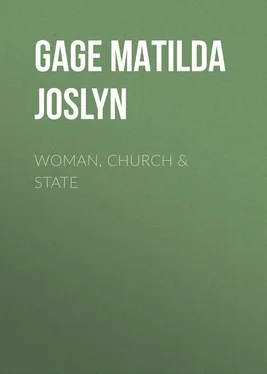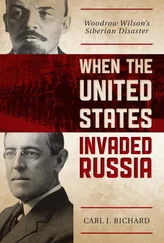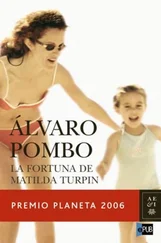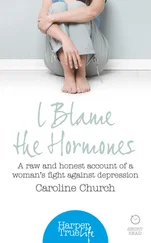Matilda Gage - Woman, Church & State
Здесь есть возможность читать онлайн «Matilda Gage - Woman, Church & State» — ознакомительный отрывок электронной книги совершенно бесплатно, а после прочтения отрывка купить полную версию. В некоторых случаях можно слушать аудио, скачать через торрент в формате fb2 и присутствует краткое содержание. Жанр: foreign_antique, foreign_prose, на английском языке. Описание произведения, (предисловие) а так же отзывы посетителей доступны на портале библиотеки ЛибКат.
- Название:Woman, Church & State
- Автор:
- Жанр:
- Год:неизвестен
- ISBN:нет данных
- Рейтинг книги:3 / 5. Голосов: 1
-
Избранное:Добавить в избранное
- Отзывы:
-
Ваша оценка:
- 60
- 1
- 2
- 3
- 4
- 5
Woman, Church & State: краткое содержание, описание и аннотация
Предлагаем к чтению аннотацию, описание, краткое содержание или предисловие (зависит от того, что написал сам автор книги «Woman, Church & State»). Если вы не нашли необходимую информацию о книге — напишите в комментариях, мы постараемся отыскать её.
Woman, Church & State — читать онлайн ознакомительный отрывок
Ниже представлен текст книги, разбитый по страницам. Система сохранения места последней прочитанной страницы, позволяет с удобством читать онлайн бесплатно книгу «Woman, Church & State», без необходимости каждый раз заново искать на чём Вы остановились. Поставьте закладку, и сможете в любой момент перейти на страницу, на которой закончили чтение.
Интервал:
Закладка:
The second step in family life took place when the father, dropping his own name, took that of his child. This old and wide-spread custom is still extant in many portions of the globe; the primitive peoples of Java, Australia and Madagascar are among those still continuing its practice. 7 7 Among many people the father at birth of a child, especially a son, loses his name and takes the one his child gets. Taylor — Primitive Culture . Also see Wilkin .
By this step the father allied himself to both mother and child, although still holding an inferior position to both. The Matriarchal family was now fully established, descent still running in the female line. Thus, as has been expressed, we find that woman’s liberty did not begin today nor under modern religions or forms or government, but that she was in reality the founder of civilization, and that in the most remote times woman enjoyed superiority of rights in all the institutions of life. 8 8 “Thus we see that woman’s liberty did not begin at the upper, but at the lower end of civilization. Woman in those remote times, was endowed with and enjoyed rights that are denied to her but too completely in the higher phase of civilization. This subject has a very important aspect, i.e. the position of woman to man, the place she holds in society, her condition in regard to her private and public (political) rights.”
And yet so difficult is it to break away from educated thought, so slight a hold have historical facts upon the mind when contrary to pre-conceived ideas, that we find people still expressing the opinion that man’s place has always been first in government. Even under those forms of society where woman was undisputed head of the family, its very existence due to her, descent entirely in the female line, we still hear assertion that his must have been the controlling political power. But at that early period to which we trace the formation of the family, it was also the political unit. And when peoples became aggregated into communities, when tribal relations were ultimately recognized, woman still held superior position, and was the controlling power in government, and never was justice more perfect, never civilization higher than under the Matriarchate. Historians agree as to the high civilization even today of those nations or tribes still preserving traces of Matriarchal customs. Even under its most degenerate form, the family, governmental and religious rights of women are more fully recognized than under any phase of Christian civilization. In all the oldest religions, equally with the Semitic cults, the feminine was recognized as a component and superior part of divinity, goddesses holding the supreme place. Even at much later periods woman shared equally with man in the highest priestly offices, and was deified after death. In Egypt, Neith the Victorious, was worshiped as mother of the gods, and in the yearly festival held in her honor, every family took part for the time holding a priestly office. To neglect this duty was deemed an omission of great irreverence. 9 9 “Among the monogamous classic nations of antiquity, the maternal deity was worshiped with religious ceremonies.”
The most ancient occultism recognized the creative power as feminine and preceding both gods and men.
Under the Matriarchate, monogamy was the rule; neither polyandry or promiscuity existed. 10 10 We find the mother’s right exclusively together with a well-established monogamy. — Bachofen .
For long years after the decline of the Matriarchate we still discover that among many of the most refined nations, woman still possessed much of the power that belonged exclusively to her during that early period. Ancient Egypt, recognized as the wisest nation since the direct historic period, traced descent even to the throne in the female line. To this reminiscence of the Matriarchate are we indebted for the story of Moses and his preservation by an Egyptian princess in direct contravention of the Pharaoh’s orders, as told by the Bible and Josephus. She not alone preserved the child’s life but carried him to the king as her son given to her by the bounty of the river and heir to his throne. As showing woman’s power in that kingdom, the story is worthy of being farther traced. Josephus says that to please his daughter, the king took the child in his arms, placing his crown on the baby head, but the chief priest at that moment entering the room, in a spirit of prophecy cried aloud, “Oh King; this is the child of whom I foretold danger; kill him and save the nation,” at the same time striving to take the babe from the king. But the princess caught him away, thus setting both kingly and priestly power at defiance, taking this step by virtue of her greater authority, protecting him until he reached manhood and causing him to be educated in all the wisdom of the Egyptians, in a college under her own control. Nor in the supreme hour of the nation’s peril, when the king, too old to lead his armies to battle, demanded Moses as heir to the throne in his place, would she give him up until she had exacted an oath from her father, the potent Pharaoh, that he meant the youth no harm.
The famous Iroquois Indians, or Six Nations, which at the discovery of America held sway from the great lakes to the Tombigbee river, from the Hudson to the Ohio, and of whom it has been said that another century would have found them master of all tribes to the Gulf of Mexico on the south, and the Mississippi on the west, showed alike in form of government, and in social life, reminiscences of the Matriarchate. The line of descent, feminine, was especially notable in all tribal relations such as the election of Chiefs, and the Council of Matrons, to which all disputed questions were referred for final adjudication. No sale of lands was valid without consent of the squaws and among the State Archives at Albany, New York, treaties are preserved signed by the “Sachems and Principal Women of the Six Nations.” 11 11 Documentary History of New York .
The women also possessed the veto power on questions of war. Sir William Johnston mentions an instance of Mohawk squaws forbidding the war-path to young braves. The family relation among the Iroquois demonstrated woman’s superiority in power. When an Indian husband brought the products of the chase to the wigwam, his control over it ceased. In the home, the wife was absolute; the sale of the skins was regulated by her, the price was paid to her. If for any cause the Iroquois husband and wife separated, the wife took with her all the property she had brought into the wigwam; the children also accompanied the mother, whose right to them was recognized as supreme. So fully to this day is descent reckoned through the mother, that blue-eyed, fair-haired children of white fathers are numbered in the tribe and receive both from state and nation their portion of the yearly dole paid to Indian tribes. The veriest pagan among the Iroquois, the renowned and important Keeper of the Wampum, and present sole interpreter of the Belts which give the most ancient and secret history of this confederation, is Ephraim Webster, descended from a white man, who, a hundred or more years since, became affiliated through marriage with an Indian woman, as a member of the principal nation of the Iroquois, the Onondagas. As of yore, so now, the greater and lesser Council Houses of the Iroquois are upon the “mountain” of the Onondaga reservation a few miles from the city of Syracuse, New York. Not alone the Iroquois but most Indians of North America trace descent in the female line; among some tribes woman enjoys almost the whole legislative authority and in others a prominent share. 12 12 Alexander: History of Women .
Lafitte and other Jesuit missionary writers are corroborated in this statement by Schoolcraft, Catlin, Clark, Hubert Bancroft of the Pacific coast, and many students of Indian life and customs. But the most notable fact connected with woman’s participation in governmental affairs among the Iroquois is the statement of Hon. George Bancroft that the form of government of the United States, was borrowed from that of the Six Nations. 13 13 History of the United States, Vol. I.
Thus to the Matriarchate or Mother-rule is the modern world indebted for its first conception of inherent rights, natural equality of condition, and the establishment of a civilized government upon this basis. Although the reputation of the Iroquois as warriors appears most prominent in history, we nevertheless find their real principles to have been the true Matriarchal one of peace and industry. Driven from the northern portion of America by vindictive foes, compelled to take up arms in self-protection, yet the more peaceful occupations of hunting and agriculture were continually followed. Their history was preserved by means of wampum, while under their women the science of government reached the highest form known to the world. Among the Zunis of New Mexico, woman still preserves supreme religious and political authority; the Paramount Council consisting of six priests under control of a supreme priestess who is the most important functionary of the tribe. 14 14 Cushing .
This form of government is traceable to their earliest civilization at which period their cities were grouped in sevens, six of them constructed upon a uniform plan; the supreme seventh containing six temples clustered about a supreme central seventh temple. While male priests ruled over the six primal cities the central and superior seventh was presided over by a priestess who not alone officiated at the central temple, but to whom the male priests of the six cities and six inferior temples were subservient. The ancient Lycians, the Sclavs, the Basques of Spain, 15 15 “What is most to be considered in this respect are the political rights which women in time of the Matriarchate shared with the men. They had indeed the right to vote in public assemblies still exercised not very long ago among the Basques in the Spanish provinces.”
the Veddas of Ceylon, 16 16 That the Veddas are the aborigines of Ceylon may be assumed from the fact that the highly civilized Singalese admit them to be of noble rank. Pre-Historic Times . – Lubbuck.
the inhabitants of Malabar, the aborigines of widely separated lands, all show convincing proof of woman’s early superiority in religion, in the state, and in the family. Monogamy was a marked feature of the Matriarchate. Bachofen, who has written voluminously upon the Matriarchate, recognizes it as peculiarly characteristic of woman’s government. He also says the people who possessed the Mother-rule together with Gynaikokraty (girls’ rule) excelled in their love of peace and justice. Under the Matriarchal family and tribal system even long after its partial supersedence by the incoming Patriarchate, the marriage relation was less oppressive to woman than it has been under most centuries of christian civilization. Daughters were free in their choice of husbands, no form of a force or sale existing. 17 17 “We find in some instances this independence of the maiden in regard to disposing of her hand, or selecting a husband as a memento of the time of the Matriarchate… The most remarkable instance of the self-disposition of woman we find among the ancient Arabs and the Hindoos; among the latter the virgin was permitted to select her own husband if her father did not give her in marriage within three years after her maturity.”
Интервал:
Закладка:
Похожие книги на «Woman, Church & State»
Представляем Вашему вниманию похожие книги на «Woman, Church & State» списком для выбора. Мы отобрали схожую по названию и смыслу литературу в надежде предоставить читателям больше вариантов отыскать новые, интересные, ещё непрочитанные произведения.
Обсуждение, отзывы о книге «Woman, Church & State» и просто собственные мнения читателей. Оставьте ваши комментарии, напишите, что Вы думаете о произведении, его смысле или главных героях. Укажите что конкретно понравилось, а что нет, и почему Вы так считаете.












